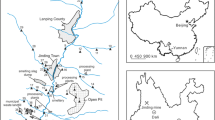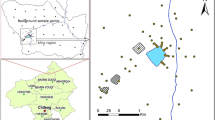Abstract
Purpose
The Qixia mine is one of the largest lead-zinc mines in Eastern China and has been operational for approximately 60 years. Source identification for trace element contamination of soils in the Qixia mining area has been lacking. This report details the evaluation and source identification of trace element contamination (including Cu, Zn, Pb, Cd, Hg, Cr, As, and Ni) of soils in this area.
Materials and methods
Thirty-three soil samples from roadsides and fields in the study area were collected and analyzed. The index of geo-accumulation (I geo) was employed to evaluate contamination. Methods of multivariate statistical analysis were used to determine the probable sources of the pollutants.
Results and discussion
The analysis showed that the levels of contamination ranked in the following order: Cd > Pb/Zn> > As/Cu> > Hg > Cr/Ni. In the sampling area nearest the mine, soil samples collected from roadsides showed much higher levels of contamination than those collected from fields away from the roadways. Trace element contamination decreased as the distance from the mine increased. Contamination extended to a distance of approximately 700 m from mineral transportation routes, with the area of greatest impact at 200 m or less. Multivariate statistical analysis and ore composition data suggest that the Cu, Zn, Pb, Cd, and As found in the soil samples originate from anthropogenic sources. Ni and Cr are considered to be at natural background concentrations.
Conclusions
This study distinguished between natural and anthropogenic sources of trace element contamination in the soils of the Qixia mining area. The contamination of Cu, Zn, Pb, Cd, and As is linked to the mining activities and is likely due to the transportation of ore concentrates and tailings.



Similar content being viewed by others
References
Baize D, Gilkes RJ, Prakongkep N (2010) Concentrations of trace elements in soils: the three keys. 19th World Congress of Soil Science, Soil Solutions for a Changing World, pp 1–4
Cai JH (2007) Research on technological mineralogy of silver in Qixiashan of Nanjing lead zinc silver deposit. Miner Resour Geol 21:196–199 (in Chinese with English abstract)
Chen YH, Huang SH, Liu SH, Wang GP, Ding F, Shao ZC, Shen ZG (2006) Study of the heavy metal contamination in soils and vegetables in Nanjing area. Resour Environ Yangtze Basin 15:357–360 (in Chinese with English abstract)
Cheng S (2003) Heavy metal pollution in China: origin, pattern and control. Environ Sci Pollut Res 10:192–198
Chu BB, Luo LQ (2010) Evaluation of heavy metal pollution in soils from Nanjing Qixia lead-zinc mine. Rock Miner Anal 29(5–8):13 (in Chinese with English abstract)
CNEMC, (China National Environmental Monitoring Centre) (1990) The background values of elements in soils of China. China Environmental Science Press, Beijing (in Chinese)
Desaules A (2012) Critical evaluation of soil contamination assessment methods for trace metals. Sci Total Environ 426:120–131
Filgueiras AV, Lavilla I, Bendicho C (2004) Evaluation of distribution, mobility and binding behaviour of heavy metals in surficial sediments of Louro River (Galicia, Spain) using chemometric analysis: a case study. Sci Total Environ 330:115–129
Forstner U (1995) Land contamination by metals: global scope and magnitude of problem. In: Allen HE, Huang CP, Baley GW, Bowers ER (eds) Metal speciation and contamination of soil. CRC Press, Boca Raton, Florida, pp 1–33
Fu S, Wei CY (2013) Multivariate and spatial analysis of heavy metal sources and variations in a large old antimony mine, China. J Soils Sediments 13:106–116
GNBVS, (The Group of Natural Background Values of Soil, Academia Sinica) (1979) The natural background values of some trace elements in the important soil types of Beijing and Nanjing areas. Acta Pedol Sin 16:319–328 (in Chinese with English abstract)
Hough RL, Breward N, Young SD, Crout NMJ, Tye AM, Moir AM, Thornton I (2004) Assessing potential risk of heavy metal exposure from consumption of home-produced vegetables by urban populations. Environ Health Perspect 112:215
Hu ZQ (1985) Study on the primary halo and the phase of mercury in Qixia lead-zinc mine. Geol Explor 9:51–57 (in Chinese)
Hu RZ, Liu JM, Zhai MG (2010) Mineral resources science and technology in China: a roadmap to 2050. Science Press Beijing, Beijing; Springer, Heidelberg
Ji YQ, Feng YC, Wu JH, Zhu T, Bai ZP, Duan CQ (2008) Using geoaccumulation index to study source profiles of soil dust in China. J Environ Sci 20:571–578
Li MS, Luo YP, Su ZY (2007) Heavy metal concentrations in soils and plant accumulation in a restored manganese mineland in Guangxi, South China. Environ Pollut 147:168–175
Liu HY, Probst A, Liao BH (2005) Metal contamination of soils and crops affected by the Chenzhou lead/zinc mine spill (Hunan, China). Sci Total Environ 339:153–166
Loska K, Wiechula D, Korus I (2004) Metal contamination of farming soils affected by industry. Environ Int 30:159–165
Moreno-Jiménez E, García-Gómez C, Oropesa AL, Esteban E, Haro A, Carpena-Ruiz R, Tarazona JV, Peñalosa JM, Fernández MD (2011) Screening risk assessment tools for assessing the environmental impact in an abandoned pyritic mine in Spain. Sci Total Environ 409:692–703
Muller G (1969) Index of geoaccumulation in sediments of the Rhine River. GeoJournal 2:108–118
Pruvot C, Douay F, Hervé F, Waterlot C (2006) Heavy metals in soil, crops and grass as a source of human exposure in the former mining areas. J Soils Sediments 6:215–220
Qu CS, Sun K, Wang SR, Huang L, Bi J (2012) Monte Carlo simulation-based health risk assessment of heavy metal soil pollution: a case study in the Qixia mining area, China. Hum Ecol Risk Assess 18:733–750
Shen L, Cheng S, Gunson AJ, Wan H (2005) Urbanization, sustainability and the utilization of energy and mineral resources in China. Cities 22:287–302
USEPA (1994) Method 200.8: Determination of trace elements in waters and wastes by inductively coupled plasma-mass spectrometry, Revision 5.4, EMMC Version. US Environmental Protection Agency, Office of Research and Development, Environmental Monitoring and Systems Laboratory
USEPA (1998) Method 7473 (SW-846): mercury in solids and solutions by thermal decomposition, amalgamation, and atomic absorption spectrophotometry, Revision 0. US Environmental Protection Agency, Office of Research and Development, Environmental Monitoring and Systems Laboratory
Wang QR, Dong Y, Cui Y, Liu X (2001) Instances of soil and crop heavy metal contamination in China. Soil Sediment Contam 10:497–510
Wang X, He M, Xie J, Xi J, Lu X (2010) Heavy metal pollution of the world largest antimony mine-affected agricultural soils in Hunan province (China). J Soils Sediments 10:827–837
Wei BG, Yang LS (2010) A review of heavy metal contaminations in urban soils, urban road dusts and agricultural soils from China. Microchem J 94:99–107
Wei MA, He Z, Liao JC, Wang FH (2008) The sci-tech based innovation mode of energy conservation and emission reduction of Qixia lead-zinc mine in Nanjing. Proceedings of the Seventh Annual Academic Symposium of the Nonferrous Metals Society of China 180–182 (in Chinese)
Wu RQ (2008) The characteristics and comprehensive utilization of lead/zinc mineral resources in China. China Met Bull 8:32–33 (in Chinese)
Zhang XY, Tang LS, Zhang G, Wu HD (2009) Heavy metal contamination in a typical mining town of a minority and mountain area, South China. Bull Environ Contam Toxicol 82:31–38
Zhang X, Yang L, Li Y, Li H, Wang W, Ye B (2012) Impacts of lead/zinc mining and smelting on the environment and human health in China. Environ Monit Assess 184:2261–2273
Zhuang P, Zou B, Li NY, Li ZA (2009) Heavy metal contamination in soils and food crops around Dabaoshan mine in Guangdong, China: implication for human health. Environ Geochem Health 31:707–715
Acknowledgments
This research was supported by the Chinese Natural Sciences Foundation (41271014 & 41171411), the Chinese Natural Sciences Youth Foundation (41201545), and the Jiangsu Province Science and Technology Supporting Foundation (BE2013720). The authors would also like to thank John Londergan and Lucy S. Tashman for assistance rendered to improve the language.
Author information
Authors and Affiliations
Corresponding author
Additional information
Responsible editor: Jean-Paul Schwitzguébel
Rights and permissions
About this article
Cite this article
Ma, Z., Li, T., Qu, C. et al. Evaluation and source identification of trace element contamination of soils in the Qixia lead-zinc mining area, Jiangsu, China. J Soils Sediments 14, 1703–1712 (2014). https://doi.org/10.1007/s11368-014-0900-x
Received:
Accepted:
Published:
Issue Date:
DOI: https://doi.org/10.1007/s11368-014-0900-x




